What are Gallbladder Diseases? Symptoms and Treatment Methods
İçindekiler
Gallbladder Diseases
A pear-shaped organ, the gallbladder is located in the right part of the abdomen. The gallbladder, which holds a digestive fluid called bile, can become inflamed. Gallbladder inflammation is called cholecystitis. Caused by a gallstone blocking the tube in the gallbladder, cholecystitis can lead to serious illness. A rupture of the gallbladder can result from inflammation. Treatment of cholecystitis may result in the removal of the gallbladder. Age and weight are factors that increase the risk of cholecystitis. Experienced more intensely in females, this problem negatively affects the life of the person.
Gallstones, also called bilirubin stones, are among common gallbladder disease in Asia. Gallstones, also known as cholesterol stones, are more likely to form with increasing age especially in western countries. Symptoms of this disease are characterized by abdominal pain, which radiates to the back. Although these pains can be constant and severe, they can also be temporary. Occurring in the bile duct, these stones cause obstruction and bring with them complaints such as fever and inflammation. Moreover, vomiting and nausea are also symptoms of gallstones.
Diagnosing Gallbladder Diseases
With accurate diagnosis and treatment methods through ultrasonography, radiologically diagnosed patients can regain their health. Stones in the gallbladder cause problems such as gallbladder cancer, acute pancreatitis, obstructive jaundice, perforation of the gallbladder and acute cholecystitis. Complaints, with successful treatment methods, help patients to move away from the problems they suffer from.
One of the disorders caused by the gallbladder, inflammation of the gallbladder, causes edema and thickening of the gallbladder wall. It may be detected during the examination of acute cholecystitis, which manifests itself with factors such as fever, vomiting, nausea and severe abdominal pain. Acute cholecystitis is a serious and urgent condition that can lead to hospitalization. The patient is given broad-spectrum antibiotics and surgical treatment is performed. Besides, among gallbladder diseases, another problem is bile duct injuries and strictures.
Why do Gallbladder Diseases Occur?
Technical errors and anatomical differences can cause bile to flow into the abdomen as a result of bile duct injuries. In the event that bile flows into the abdomen, the person needs to be treated urgently. Attacks of biliary tract inflammation can occur if there is a complete blockage or narrowing of the bile duct. Different treatment methods can be applied for narrowing or complete obstruction of the biliary tract, which also brings problems such as itching and jaundice in the patient.
Untreated bile duct strictures or injuries can lead to cirrhosis, liver failure, inflammation of the bile ducts, jaundice and new strictures. Obstructive jaundice occurs when bile stops flowing into the intestine. In cases of obstructive jaundice, yellowing of the skin may occur. Left untreated, the liver tissue may deteriorate in the future, which can lead to liver tumors.
Identification and Treatment Methods of Gallbladder Diseases
Patients with obstructive jaundice have darker urine and whiter stools. It is necessary to treat obstructive jaundice correctly, which is determined by different diagnostic methods such as magnetic resonance imaging, computed tomography, and ultrasonography. Treatment can be completed with different applications depending on the patient’s condition, especially endoscopic treatments.
Cholecystitis, which is found in the biliary tract, is another problem among gallbladder diseases. Also known as cholecystitis, biliary tract cysts, which are caused by abnormal dilatation of the bile ducts, can occur for different reasons such as fever, liver abscess, biliary obstruction. For the diagnosis of this disease, methods such as tomography, ERCP, MRCP can be applied.
In case small problems in the gallbladder are not treated in time, they can lead to bigger problems in the future. Malignant tumors can cause gallbladder cancer. Usually, gallbladder cancer originates in the walls of the gallbladder. There are risk factors for gallbladder cancer, including nitrosamine, obesity, porcelain gallbladder, polyps and gallstones.
It can be treated surgically with gallbladder cancer, which manifests itself with abdominal pain and jaundice. Part or all of the liver tissue can be removed along with the gallbladder in gallbladder cancer surgery, where the gallbladder is removed. The doctor’s advice is important in the surgical procedure. Please remember that if you have severe pain in the upper right side of your abdomen under the ribs, it may be due to gallstones and if inflammation is detected, it is very important to have surgery immediately without delay.
Gallbladder Inflammation and Symptoms
Cholecystitis, inflammation of the gallbladder, can render the gallbladder dysfunctional. Bile fluid produced by the liver is a digestive fluid. It is stored temporarily in the gallbladder. Once the body wants to break down fats, the gallbladder ensures that bile is released into the small intestine. However, obstruction of the pathways in the small intestine can trap bile and irritate the gallbladder.
Irritation of the gallbladder leads to gallbladder inflammation. This condition is characterized by nausea and vomiting. These symptoms may occur after an excessively fatty meal or large portions. Pain in the right shoulder blade is another way to recognize cholecystitis, which is often confused with other health problems.
Why Gallbladder Inflammation Occurs?
Gallbladder inflammation is not something to be ignored. If not treated in time, the inflammation can lead to the removal of the gallbladder. Gallbladder inflammation is caused by bile soils or stones blocking the small intestinal tract. Blood vessel problems, infection, and tumors are other triggers for inflammation. Gallstones are hard particles that form in the gallbladder.
Inflammation occurs when gallstones leave the gallbladder, block the tube through which they pass and bile accumulates in this area. Furthermore, a tumor in the gallbladder can prevent bile from draining properly from the gallbladder.
Other Factors Triggering Gallbladder Inflammation
Causes of cholecystitis include an injury to the bile ducts or blockage of the ducts. In addition, some viral infections and viruses such as AIDS can trigger the infection. Problems with blood vessels can also cause impaired blood flow to the gallbladder. All these elements are factors that cause cholecystitis. Cholecystitis, which can also occur suddenly, is called acute cholecystitis.
If the discomfort persists for a long time, it can lead to chronic cholecystitis. Gallbladder inflammation can cause the bile tissue to die. A burst or ruptured gallbladder is also possible. It is particularly common among diabetics, people awaiting treatment, and the elderly.
Gallbladder Cancer
The gallbladder, located in the lower part of the liver, is a pear-shaped organ. This organ, which is composed of muscle, provides bile retention as a result of the bile produced in the liver pouring into the bile duct through the ductules. The path to the gallbladder is transmitted by a tributary, which is formed before it reaches the duodenum. In this way, bile produced by the liver in a regular and small amount is collected in the pouch. The life of the person is negatively affected by tumors that can form in the gallbladder, which allows the bile produced by the liver to be temporarily stored.
It is an organ that stores bile produced in the liver for a period of time, absorbs the water in it to form thick bile and excretes it into the common bile duct after food intake, especially fatty food intake. Passing from the gallbladder into the common bile duct, bile is then excreted into the duodenum (duodenum), where it acts as the main factor in the digestion of fatty foods. Various diseases and cancer of the gallbladder are treated surgically by removing the gallbladder.
In gallbladder cancer, it is sometimes necessary to remove adjacent liver tissue and surrounding lymph nodes. Today, almost all gallbladder surgeries (except in exceptional cases) can be performed by laparoscopic and robotic surgery with the closed method.
A family history of gallbladder cancer puts people at risk. Although being in a risk group does not mean that a person will get cancer, it is recommended that they undergo regular health checks.
Among cancers of the abdominal organs, gallbladder cancer is one of the rarest tumors. It is however very important that it is detected at an early stage and treated appropriately. Unfortunately, gallbladder cancers detected at an advanced stage have a short life expectancy.
Gallbladder cancer is roughly divided into four stages. Patients detected in the first stage have a very good outcome when treated appropriately. In second stage patients, removal of the gallbladder and the segments of the liver adjacent to the gallbladder and a very good lymph node cleansing is usually required. In the third and fourth stages, treatment success decreases.
The only way to achieve a long life expectancy in gallbladder cancer is early diagnosis and quality and proper surgical treatment. The success of surgical treatment, and therefore survival, is determined by the extent to which the cancerous tissue has spread from the gallbladder. Below is a large image of the liver showing the gallbladder (yellow) and its wall structure, the main bile ducts (green), and the main feeding vessels of the liver (purple).
Below, the small images show the stages of the spread of cancerous tissue from the pouch. It is a small round red cancer that is confined within the sac and a large red round cancer that has reached the border of the liver through the wall of the sac but has not yet spread to the liver. Once detected at these two stages, the patient has a very high chance of a long life with good surgery. In the third stage (stage T3), the cancerous tissue has spread to the liver. In the fourth picture (T4 stage), not only has the cancerous tissue spread to the liver, but it has also invaded the purple-colored main vein of the liver.
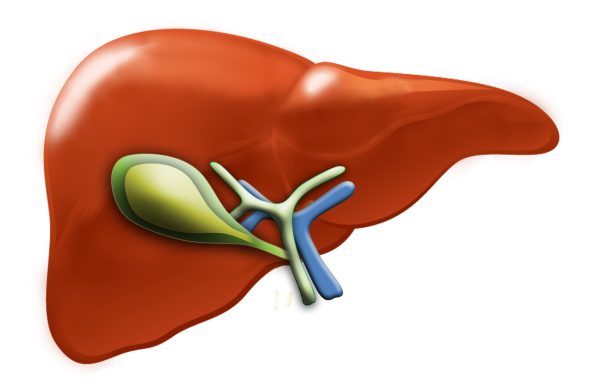
Gallbladder Tumor The early stage limited to the sac (T1)
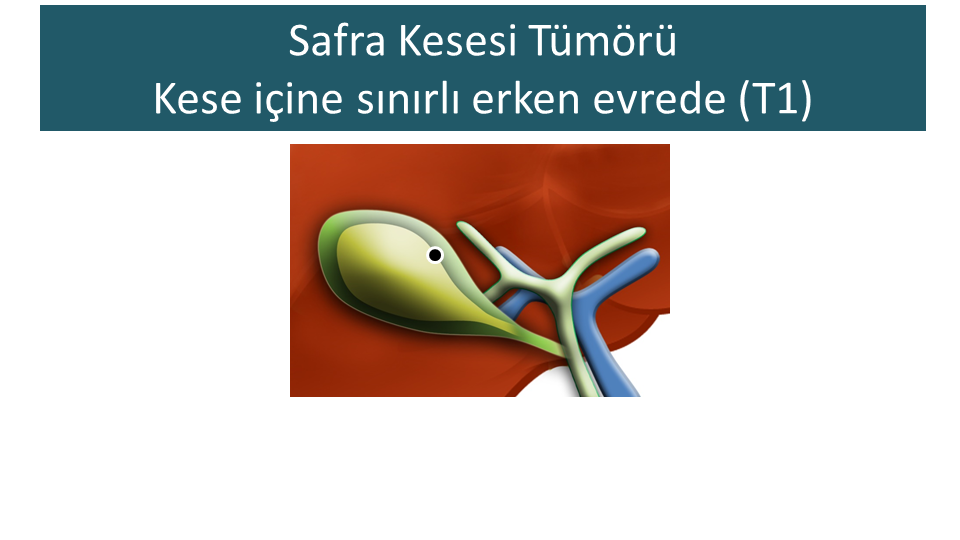
Gallbladder Tumor It's not in the liver, it's in the wall of the sac.
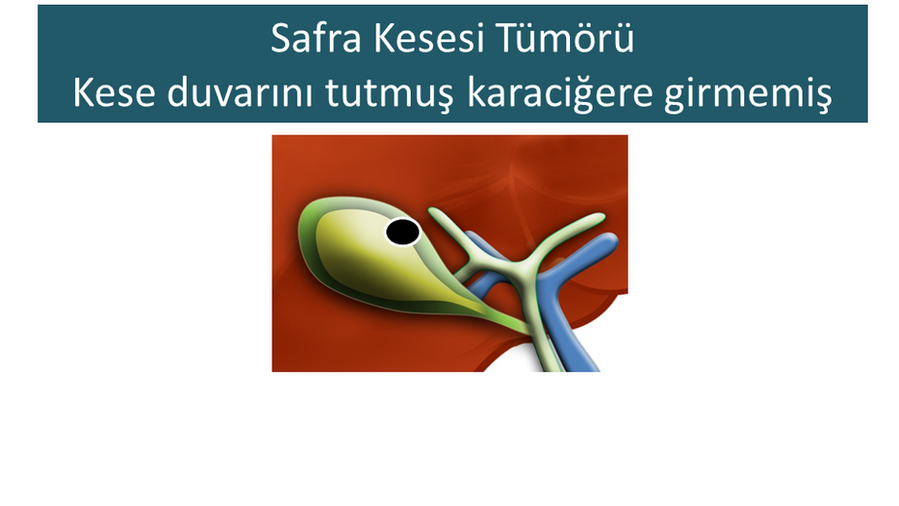
Gallbladder Tumor Involved the liver beyond the wall of the sac (T3)
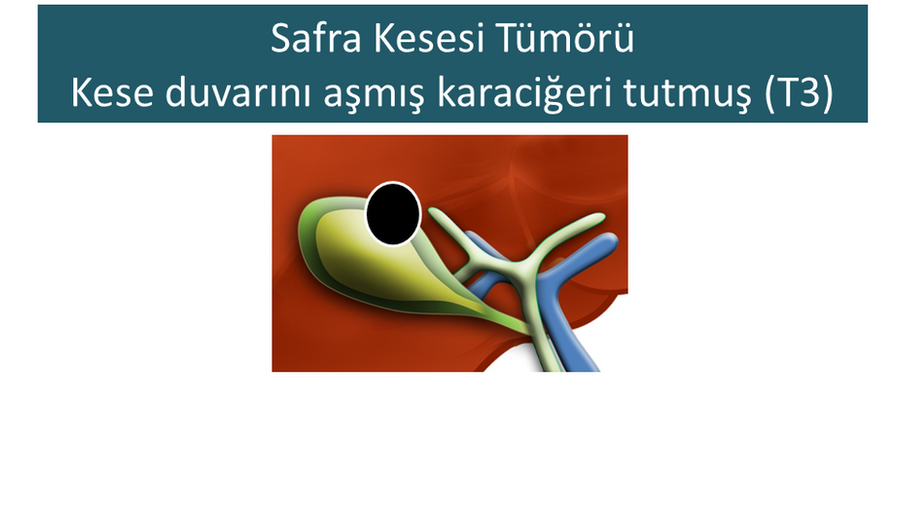
Gallbladder Tumor Involved liver and main vessel (T4)
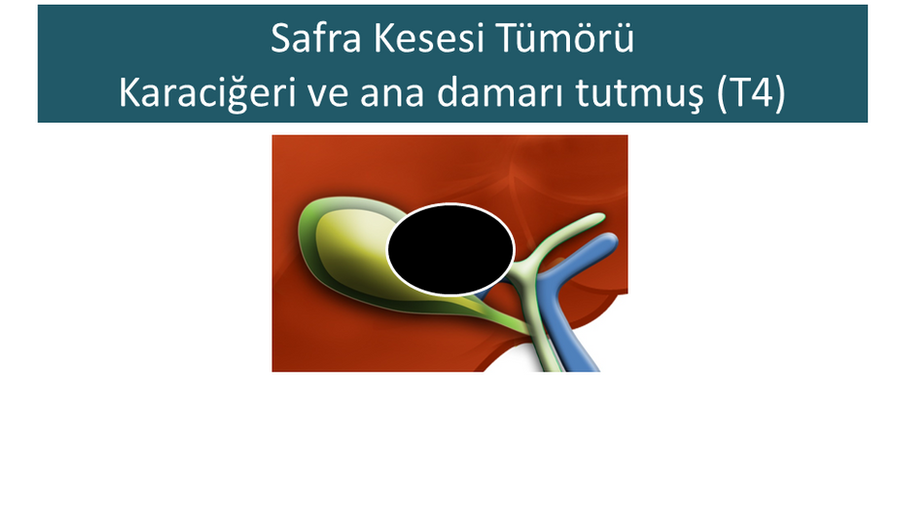
Risk Factors for Gallbladder Cancer
Factors of gallbladder cancer are not clearly known, but many points may constitute risk factors. It may be triggered by factors such as obesity, advancing age, and the presence of stones in the gallbladder for a long time. Furthermore, triggers for gallbladder cancer include nitrosamine and inflammation of the gallbladder. Symptoms of gallbladder cancer generally include a palpable mass in the umbilical region, yellowing of the skin and eyes, nausea, vomiting, abdominal and belly pain.
A series of laboratory tests can be performed to make the diagnosis. Laboratory tests show elevated levels of alkaline phosphatase and bilirubin, which are among the markers of gallbladder cancer. To differentiate the findings from benign tumors, imaging tests such as computed tomography are performed.
Technology Used to Image the Biliary Tract
To detect whether the tumor or tumors in the gallbladder are malignant, imaging tests are used. Cholangiography is the device used to visualize the bile ducts. Imaging devices such as ERCP and angiography are used to visualize the bile ducts and blood vessels. It is also important to note that factors such as the presence or absence of other health problems, the age of the patient, the stage of the disease and the location of the disease can determine the type of treatment.
Therefore, the treatment of each patient may differ. Chemotherapy, radiotherapy and surgical interventions can help the patient regain their health. Multidisipliner bir çalışma gerektiren bu süreçte en doğru kararı doktorunuz, muayene sonrasında verecektir.
Treatment of Gallbladder Diseases
Treatment of the gallbladder can be applied to eliminate the disorders occurring in the gallbladder. Gallbladder disorders, which can be painful, can prevent the fulfillment of various functions in the body. A gallstone is less common in males than in females. Approximately 1 liter of bile is secreted daily and has various functions, such as the absorption of vitamins and the digestion of fats. Bile is produced by the liver and on its journey from the liver to the duodenum, it pauses in the gallbladder where it accumulates. The bile is absorbed into the gallbladder, which absorbs the bile water and gives it a thicker consistency.
It is used for the comfortable digestion of various foods, especially fatty foods, and many different diseases can occur in the gallbladder. A wide range of conditions such as inflammation of the gallbladder, obstruction of the common bile ducts, obstruction of the pancreatic duct, gallbladder cancer, etc. should be treated as soon as they are detected.
Risk Factors for Gallbladder Diseases
Risk factors for gallbladder diseases include liver diseases, rapid weight loss, diabetes, fiber-poor diet, pregnancy, obesity, being over 40, and gender. Various diagnostic methods such as ultrasonography, stool, and urine tests can be used to diagnose diseases. Treatment methods can be applied with the recommendation of the doctor after the diagnosis is made. Since each person’s structure is different, treatment practices may also differ.
It is very important in concentrating and storing the bile produced by the liver, and gallstones can also be seen in the gallbladder. Gallstones, which are pebble-like structures, are basically divided into two groups: pigment and cholesterol stones.
Diagnosis of Gallbladder Diseases
The conditions revealed by MRI scans, ultrasound, and blood tests hurt a person’s life. Gallbladder surgery may involve possible risks such as anesthesia risks, infection, bleeding, and bile leakage. In preparation for gallbladder surgery, your doctor may ask you to eat differently than usual. Open surgery, i.e. cholecystectomy can also be performed depending on the patient’s condition.
In open surgeries, the gallbladder is exposed through a 15-centimeter incision under the rib. In closed surgery, the patient can go home on the same day. Open surgery requires a few days of recovery. After gallbladder removal surgery, the patient should contact his/her doctor again if problems such as significant redness and swelling of the incision, foul-smelling or bloody drainage from the incision, vomiting, high fever, and worsening pain occur.
Treatment Methods Applied in Gallbladder Diseases
Causing the gallbladder to become dysfunctional, gallstones can occur during menopause, hormone treatments, use of birth control pills and pregnancy. In addition, factors such as hormones and obesity also trigger gallstone formation. In such cases, removal of the gallbladder can be performed or preventive treatment methods can be applied.
Both surgical and non-surgical treatment methods are determined according to the patient’s condition. Treatments may include surgical interventions or medication. Patients who develop complications and symptoms may need surgery. Consult your doctor for the right treatment for different diseases such as inflammation of the pancreas, inflammation of the biliary tract, jaundice, and gallbladder inflammation.
Gallbladder Surgery
Used to store bile produced by the liver, the gallbladder has an important function for the body. It helps in the ideal digestion of many different foods, especially fatty foods, and disorders in the gallbladder may require surgery. The first factor that is the subject of gallbladder surgery is gallstones. An unbalanced chemical structure of bile in the gallbladder triggers the formation of gallstones.
To avoid gallstone formation, fried and fatty foods should be avoided. Caused by problematic stones in the gallbladder, removal of the gallbladder (cholecystectomy) is one of the most common surgical procedures performed in the community. Hence, it is performed in almost every hospital in our country.
However, surgery becomes more difficult if the stone has caused inflammation of the gallbladder (this is called acute cholecystitis), increasing the risk of conversion from laparoscopy to open surgery and the risk of injury to the biliary tract during surgery. Especially if people who have already had an inflammatory attack have another attack without surgery, these risks increase slightly with each attack. In this group of patients, treatment by the specialized liver and pancreatic surgeons reduces the risks.
Why Gallstone Occurs?
Gallstones can develop in the gallbladder if it is not functioning properly in terms of the above-mentioned function of making bile more viscous and storing it. This usually occurs when the bile, whose content has changed and has begun to lose its liquid quality, first becomes muddy and then turns to stone. Gallstones that develop in Caucasians like us are usually brown-colored stones called cholesterol stones that appear in a sac.
In the Far Eastern countries such as China, Singapore, Korea, Japan and other countries of the yellow race, pigment stones, which are darker in color and appear both in the sac and in the bile ducts in the liver, develop. Gallstones often remain in the gallbladder for years without any symptoms or signs. If these stones are not large enough to fall into the common bile duct, they may not need to be treated.
However, when the stones start to cause problems, this condition can manifest itself with mild symptoms such as mild indigestion and pain in the upper right side of the abdomen, or it can become life-threatening with fever and severe pain when it causes inflammation of the gallbladder, jaundice when it falls into the common bile duct, severe pain in the abdomen and both flanks, fever, abdominal swelling, palpitations, and general condition disorder when it presses on the pancreatic duct and causes pancreatitis. Risk factors for the formation of gallstones include high cholesterol, family history of gallstones, weight problems, being over the age of 40 and being a female.
Surgeries performed with surgical treatment methods help the person regain their health. Gallstones can form again if gallbladder surgery is not performed. Gallstones, which can cause jaundice, can obstruct the bile ducts. Laparoscopic, i.e. closed methods can be used in gallbladder surgery.
Helping the patient to return to daily life quickly, closed gallbladder surgery also ensures a short hospital stay. Pancreatitis can also occur due to gallstones. Large gallbladder polyps, gallbladder inflammation, gallstones in the bile ducts and gallstones in the gallbladder are among the conditions that require surgery.
More detailed information about Gallstones, the problems they cause, and inflammation of the gallbladder can be found in simplified form below
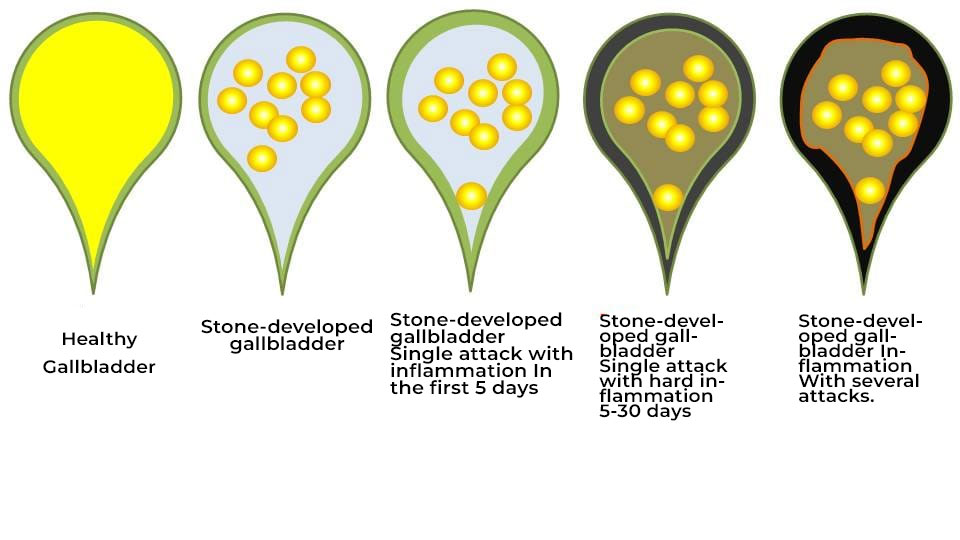
Don't underrate it gallbladder surgery! There are very important points!
Did you know that 180,000 gallbladder surgeries are performed in our country every year for gallstones and sludge, and that 1300 of them have unintended injuries to the large bile ducts during surgery? In fact, the situation in the world is close to this. Biliary tract injury develops in five per thousand patients undergoing closed gallbladder removal surgery. Such an injury is undesirable because the treatment of biliary tract injury can sometimes be quite challenging and expensive. It can take the patient beyond being a gallbladder patient and turn him/her into a liver patient. Extra surgeries and interventions are required, sometimes leading to cirrhosis (liver failure). As I said, we apply very special methods to treat these injury patients, it is very important that the patient comes to a center and a physician who can provide this treatment as soon as possible after the injury.
So are all gallbladder patients at the same risk of injury during surgery? No, it is not. The risk is slightly higher in these patients if there is inflammation due to gallstones. Gallstones can cause pain and indigestion, but if an inflammation called cholecystitis has occurred, the patient has more severe abdominal pain and sometimes fever. In these patients, surgery should be performed immediately if possible, that is, within the first 3 days, so that the inflammation is still mild and the surgery is completed before the risk increases too much. The risk of injury increases significantly if more than a week has passed since the onset of inflammatory pain. It is necessary not to operate in this case, to wait 6 weeks with medication to soften and reduce the inflammation, and then to operate.
People who suffer an attack of gallbladder inflammation once but do not undergo surgery because they think the pain has gone away are at slightly higher risk of injury if they have another attack of inflammation in the following months. Let’s not forget that the risk increases with each new attack. The risk of the surgery turning from closed to open increases with each inflammation attack. While the rate of completing the surgery with the closed method is 98% in a patient who has never had an attack, the rate of returning to open surgery increases in a person who has had several attacks and whose sac is now well-hardened. Although some surgeons complete 90% of the surgery closed in this case, this rate drops to 60% in some surgeons.
With closed surgery, the patient is usually discharged the next day, whereas with open surgery, pain is more severe and discharge can take up to 4-5 days.
Please remember that if you have severe pain in the upper right side of your abdomen under the ribs, it may be due to gallstones and if inflammation is detected, it is very important to have surgery immediately without delay.
I have summarized what I have said with the drawing above.